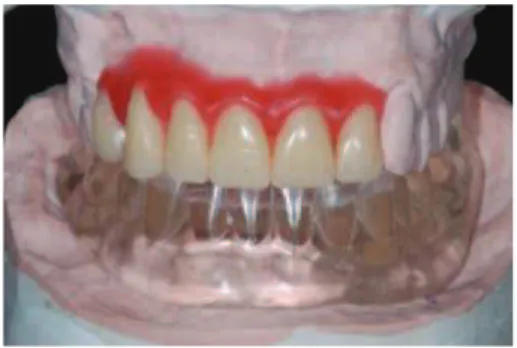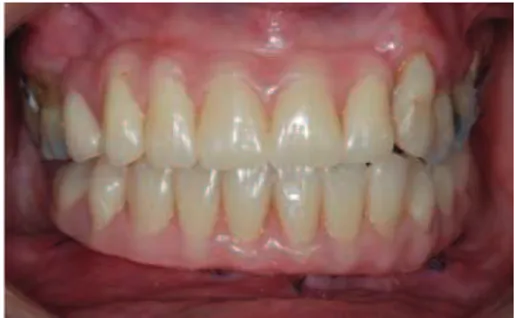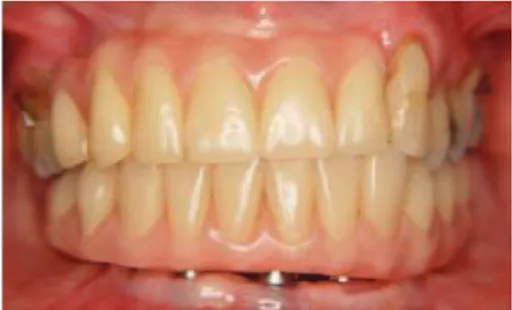Case Report
An Alternative Technique for Fabrication of Frameworks in
an Immediate Loading Implant Fixed Mandibular Prosthesis
André Gustavo Paleari,
1Cristina Dupim Presoto,
2Juliano Alencar Vasconcelos,
1José Maurício dos Santos Nunes Reis,
1Lígia Antunes Pereira Pinelli,
1Regina Helena Barbosa Tavares da Silva,
1and Cristiane Campos Costa Quishida
11Department of Dental Materials and Prosthodontics, Araraquara Dental School, Universidade Estadual Paulista (UNESP),
Rua Humait´a 1680, 14801-903 Araraquara, SP, Brazil
2Department of Restorative Dentistry, Araraquara Dental School, Universidade Estadual Paulista (UNESP), Rua Humait´a 1680,
14801-903 Araraquara, SP, Brazil
Correspondence should be addressed to Cristiane Campos Costa Quishida; criscquishida@gmail.com
Received 15 July 2014; Revised 16 December 2014; Accepted 17 December 2014
Academic Editor: Konstantinos Michalakis
Copyright © 2015 Andr´e Gustavo Paleari et al. This is an open access article distributed under the Creative Commons Attribution License, which permits unrestricted use, distribution, and reproduction in any medium, provided the original work is properly cited.
The oral rehabilitation of edentulous patients with immediate loading has become a safe procedure with high predictability. The success is related to immediate fabrication of a passive fit framework to attach the implants. Based on these considerations, this case report shows an alternative technique for mandibular rehabilitation using implants immediately loaded, where the framework was fabricated using cylinders with internal reinforcement and precast pieces, electrowelding, and conventional welding providing esthetics and function to the patient in a short period of time.
1. Introduction
The oral rehabilitation of edentulous patients using implant-supported fixed prosthesis immediately loaded is a safe pro-cedure with high predictability [1–5]. Such treatment has the advantages of immediate restoration of function and aesthetics and emotional comfort to patients, especially in cases of dental extractions and immediate implant placement. Moreover, few clinical sessions are required in view of the absence of the second surgical intervention for exposing the implants [1,3,6].
According to Romanos et al. [7], loading seems to initiate bone remodeling and to form new bone around immediately loaded implants, with a better healing of the hard and soft tissues. In addition, the implant-supported fixed complete prostheses are favored by biomechanical aspects of arrange-ment and polyhedral rigid framework connection uniting the implants, which improve the distribution of occlusal loads [8].
The rigid infrastructure prevents micromotion of the implants [9] and promotes primary stability and appropriate distribution of occlusal forces, since these are transmitted to the implants immediately after installation of the prosthesis [10]. Additionally, the fabrication of frameworks with passive adaptation to implant abutments promotes the maintenance of bone-implant interface [11–13]. The absence of passivity can cause serious complications such as bone loss and fracture of the abutments and screws [11,12,14].
Other factors that influence the success of rehabilitation with immediate loading are related to problems in casting that may occur as a result of the negligence of the dental technician during the steps involved in casting, as well as lack of knowledge about the materials and equipment used. Modifications or negligence in the process of casting or welding can cause alterations in the mechanical and struc-tural properties of any alloy that is used for fabrication of the frameworks [14]. Furthermore, inaccuracies in the im-pression procedure and incorporation of air bubbles in the
2 Case Reports in Dentistry
Figure 1: Initial clinical features.
Figure 2: Multifunctional guide.
impression material can interfere with the precision of the master cast, generating a misfit framework [15–17].
The aim of this study is to report a case of an implant-supported mandibular prosthesis using a fast and efficient technique for the fabrication of the framework using cylin-ders with internal reinforcement and precast pieces, electrow-elding, and conventional welding.
2. Case Report
The following clinical case presentation demonstrates the treatment of a 64-year-old female patient, who attended the Fixed Partial Denture Clinic of the Araraquara Dental School-Univ. Estadual Paulista (UNESP), for dental treat-ment. The patient presented clinically with tooth mobility and bone resorption in anterior mandibular arch. In addition, she was wearing an old and misfit removable partial dentures in the upper and lower arch and did not show any systemic dis-ease. Given the clinical (Figure1) and radiographic features, it was proposed to extract the remaining lower teeth and place an immediate loading implant-fixed mandibular prosthesis. This decision was made considering the bad conditions of mandibular teeth, which did not allow the rehabilitation with new removable partial dentures or another modality of dental prostheses. For the upper arch was proposed a provisional removable partial denture until the placement of bone graft with the purpose of subsequent placing dental implants.
In order to follow a protocol based on reverse planning, the intermaxillary relations were established and the casts mounted in semiadjustable articulator prior to implant place-ment. Thus, a multifunctional guide (Figure2) was fabricated from a duplicate of the wax base, after the first clinical proof,
Figure 3: Abutments installed on the implants.
Figure 4: Fragments previously cast in Ni-Cr alloy inserted into the space between the cylinders.
to maintain the esthetic and dimensional features obtained previously. After the placement of the implants (Emfils-Ind´ustria e Com´ercio de Produtos Odontol´ogicos, Itu, SP, Brazil) with a greater torque than 40 N⋅cm, the abutments were installed (Figure3) and an impression was performed using the multifunctional guide. Cylinders that were previ-ously cast in Ni-Cr alloy (Fit Cast SB-Plus Ni-Cr without Beryllium, Talladium, Curitiba-PR, Brazil) were installed on the abutment replicas in the master cast. Fragments were earlier cast in Ni-Cr alloy and obtained by means of wax patterns and inserted into the space between the cylinders (Figure4). The multifunctional guide was used as parameter to delimit the covering area to include the implants and set limits to the extent of the two distal cantilever extensions. The initial fixation of the metal fragments to cylinders was performed with an Electroweld (Kernit Mechatronics Ind. Ltd., Indaiatuba, Sao Paulo, Brazil) using orthodontic wire of 0.9 mm diameter. After primary stabilization, a conventional welding in Ni-Cr alloy was carried out, without the need to invest any wax pattern.
Figure 5: Framework after finishing.
Figure 6: Framework try-in.
(Figure7). Figures8and9show the radiographic and clinical features of the prosthesis 12 months after the installation.
3. Discussion
The oral prosthetic rehabilitation using immediate loading implants has been reported as a beneficial treatment protocol to osseointegration of the implant and that increases the comfort of the patient. The surgical and prosthetic protocols have been developed in order to reduce the time between surgery and the installation of the prosthesis [5]. In addition, this treatment protocol has showed success rates similar to the treatments performed conventionally [3–5].
This case report presents a technique option to the fast confection of metal framework for the treatment of total edentulous patients when planning the implant-supported prostheses with immediate loading. In this technique, the metallic framework is fabricated using cylinders and frag-ments previously cast in Ni-Cr alloy, electrowelding, and conventional welding to promote reduction in manufacture time of the prosthesis, allowing it to be installed in the same day or within 24 hours after the surgery of the implant placement. The speed of the treatment is important mainly for patients who initially present natural teeth and are subjected to multiple extractions and procedures for implant placement with immediate loading [1]. Additionally, it has been reported that with immediately loaded implants the patients may restart their function quickly. Any reduction in the number of the surgical procedures necessary or a decrease in the healing period is certainly very well welcomed by clinicians and patients [19].
Figure 7: Prosthesis immediately after installation.
Figure 8: Panoramic radiograph after 12 months.
In this present case, the patient was not subjected to a second surgical phase or used a conventional complete mandibular denture during the period of osseointegration period. Based on clinical and tomographic features, it was decided to fabricate an implant-supported prosthesis with immediate loading, using the technique with cylinders and fragments of precast framework, electrowelding, and conven-tional welding. In this procedure, it is not necessary to wax and embedding the framework. Consequently, it can help to achieve a passive framework, which offers lower transmission of loads to the implants and peri-implant interface, thereby reducing the presence of harmful forces that can lead to bone loss around the implant, since passively fitting frameworks are a prerequisite for long-lasting osseointegration of dental implants [20]. The adaptation and passivity of the framework were verified by means of clinical probing and dental floss and confirmed by periapical radiography. However there is agreement among the in vitro studies that there is no implant framework fabrication approach or material that can provide absolute passivity of fitted frameworks [5,11,13,21].
4 Case Reports in Dentistry
Figure 9: Clinical aspect of the prosthesis after 12 months.
be designed to assess long term success of implant-fixed prosthesis fabricated by using this technique.
Conflict of Interests
The authors declare that there is no conflict of interests regarding the publication of this paper.
Acknowledgment
The authors thank the dental technician Mr. Luiz Fernando Souza for performing all laboratory steps involved in this clinical case.
References
[1] S. J. Sadowsky, “Immediate load on the edentulous mandible:
treatment planning considerations,”Journal of Prosthodontics,
vol. 19, no. 8, pp. 647–653, 2010.
[2] M. Esposito, M. G. Grusovin, M. Willings, P. Coulthard, and H. V. Worthington, “The effectiveness of immediate, early, and conventional loading of dental implants: a cochrane systematic
review of randomized controlled clinical trials,”International
Journal of Oral and Maxillofacial Implants, vol. 22, no. 6, pp. 893–904, 2007.
[3] G. O. Gallucci, D. Morton, and H.-P. Weber, “Loading protocols
for dental implants in edentulous patients,”The International
Journal of Oral & Maxillofacial Implants, vol. 24, pp. 132–146, 2009.
[4] E. Nkenke and M. Fenner, “Indications for immediate loading of
implants and implant success,”Clinical Oral Implants Research,
vol. 17, no. 2, pp. 19–34, 2006.
[5] A. Acocella, C. Ercoli, A. Geminiani et al., “Clinical evaluation of immediate loading of electroeroded screw-retained titanium fixed prostheses supported by tilted implant: a multicenter
retrospective study,” Clinical Implant Dentistry and Related
Research, vol. 14, no. 1, pp. e98–e108, 2012.
[6] N. J. Attard, A. Laporte, D. Locker, and G. A. Zarb, “A prospec-tive study on immediate loading of implants with mandibular
overdentures: Patient-mediated and economic outcomes,”
Inter-national Journal of Prosthodontics, vol. 19, no. 1, pp. 67–73, 2006. [7] G. E. Romanos, C. G. Toh, C. H. Siar, H. Wicht, H. Yacoob, and G.-H. Nentwig, “Bone-implant interface around titanium implants under different loading conditions: a
histomorphome-trical analysis in the Macaca fascicularis monkey,”Journal of
Periodontology, vol. 74, no. 10, pp. 1483–1490, 2003.
[8] P.-I. Br˚anemark, K. Gr¨ondahl, L.-O. ¨Ohrnell et al., “Zygoma
fixture in the management of advanced atrophy of the maxilla:
technique and long-term results,” Scandinavian Journal of
Plastic and Reconstructive Surgery and Hand Surgery, vol. 38, no. 2, pp. 70–85, 2004.
[9] L. Minsk and L. F. Rose, “Immediate loading of dental implants
for mandibular prosthesis in edentulous mandibles,”
Com-pendium of Continuing Education in Dentistry, vol. 24, no. 5, pp. 346–354, 2003.
[10] L. E. Colomina, “Immediate loading of implant-fixed mandibu-lar prostheses: a prospective 18-month follow-up clinical
study—preliminary report,”Implant Dentistry, vol. 10, no. 1, pp.
23–29, 2001.
[11] S. Sahin and M. C. C¸ ehreli, “The significance of passive
frame-work fit in implant prosthodontics: current status,” Implant
Dentistry, vol. 10, no. 2, pp. 85–92, 2001.
[12] S. Longoni, M. Sartori, F. Ariello, M. Anzani, and M. Baldoni, “Passive definitive fit of bar-supported implant overdentures,”
Implant Dentistry, vol. 15, no. 2, pp. 129–134, 2006.
[13] J. Abduo, K. Lyons, V. Bennani, N. Waddell, and M. Swain, “Fit of screw-retained fixed implant frameworks fabricated
by different methods: a systematic review,”The International
Journal of Prosthodontics, vol. 24, no. 3, pp. 207–220, 2011. [14] G. G. Romero, R. Engelmeier, J. M. Powers, and A. A.
Canter-bury, “Accuracy of three corrective techniques for implant bar
fabrication,”Journal of Prosthetic Dentistry, vol. 84, no. 6, pp.
602–607, 2000.
[15] G. E. P. Henriques, S. Consani, J. M. D. de Almeida Rollo, and F. Andrade e Silva, “Soldering and remelting influence
on fatigue strength of cobalt-chromium alloys,” Journal of
Prosthetic Dentistry, vol. 78, no. 2, pp. 146–152, 1997.
[16] S. T. Swallow, “Technique for achieving a passive framework fit:
a clinical case report,”The Journal of Oral Implantology, vol. 30,
no. 2, pp. 83–92, 2004.
[17] M. R. Spector, T. E. Donovan, and J. I. Nicholls, “An evaluation
of impression techniques for osseointegrated implants,” The
Journal of Prosthetic Dentistry, vol. 63, no. 4, pp. 444–447, 1990. [18] T. Jemt, “Failures and complications in 391 consecutively inserted fixed prostheses supported by Br˚anemark implants in edentulous jaws: a study of treatment from the time of
pros-thesis placement to the first annual checkup,”The International
Journal of Oral & Maxillofacial Implants, vol. 6, no. 3, pp. 270– 276, 1991.
[19] A. G. Payne, A. Tawse-Smith, R. Kumara, and W. M. Thom-son, “One-year prospective evaluation of the early loading of unsplinted conical Br˚anemark fixtures with mandibular
overdentures immediately following surgery,”Clinical implant
Dentistry and Related Research, vol. 3, no. 1, pp. 9–19, 2001. [20] S. M. Heckmann, M. Karl, M. G. Wichmann, W. Winter, F.
Graef, and T. D. Taylor, “Cement fixation and screw reten-tion: parameters of passive fit—an in vitro study of
three-unit implant-supported fixed partial dentures,” Clinical Oral
Implants Research, vol. 15, no. 4, pp. 466–473, 2004.
[21] J. Y. Kan, K. Rungcharassaeng, K. Bohsali, C. J. Goodacre, and B. R. Lang, “Clinical methods for evaluating implant framework
fit,”The Journal of Prosthetic Dentistry, vol. 81, no. 1, pp. 7–13,
Submit your manuscripts at
http://www.hindawi.com
Hindawi Publishing Corporation
http://www.hindawi.com Volume 2014
Oral Oncology
Journal ofDentistry
International Journal ofHindawi Publishing Corporation
http://www.hindawi.com Volume 2014
Hindawi Publishing Corporation
http://www.hindawi.com Volume 2014
International Journal of
Biomaterials
Hindawi Publishing Corporation
http://www.hindawi.com Volume 2014
BioMed
Research International
Hindawi Publishing Corporation
http://www.hindawi.com Volume 2014
Case Reports in Dentistry
Hindawi Publishing Corporation
http://www.hindawi.com Volume 2014
Oral Implants
Journal ofHindawi Publishing Corporation
http://www.hindawi.com Volume 2014
Anesthesiology Research and Practice
Hindawi Publishing Corporation
http://www.hindawi.com Volume 2014
Radiology
Research and Practice Environmental and
Public Health Journal of
Hindawi Publishing Corporation
http://www.hindawi.com Volume 2014
The Scientific
World Journal
Hindawi Publishing Corporationhttp://www.hindawi.com Volume 2014
Hindawi Publishing Corporation
http://www.hindawi.com Volume 2014
Dental Surgery
Journal ofDrug Delivery
Journal of Hindawi Publishing Corporationhttp://www.hindawi.com Volume 2014
Hindawi Publishing Corporation
http://www.hindawi.com Volume 2014
Oral Diseases
Journal ofHindawi Publishing Corporation
http://www.hindawi.com Volume 2014
Computational and Mathematical Methods in Medicine
Scientifica
Hindawi Publishing Corporation
http://www.hindawi.com Volume 2014
Pain
Research and Treatment
Hindawi Publishing Corporation
http://www.hindawi.com Volume 2014 Hindawi Publishing Corporation
http://www.hindawi.com Volume 2014
Endocrinology
International Journal ofHindawi Publishing Corporation
http://www.hindawi.com Volume 2014
Hindawi Publishing Corporation
http://www.hindawi.com Volume 2014


